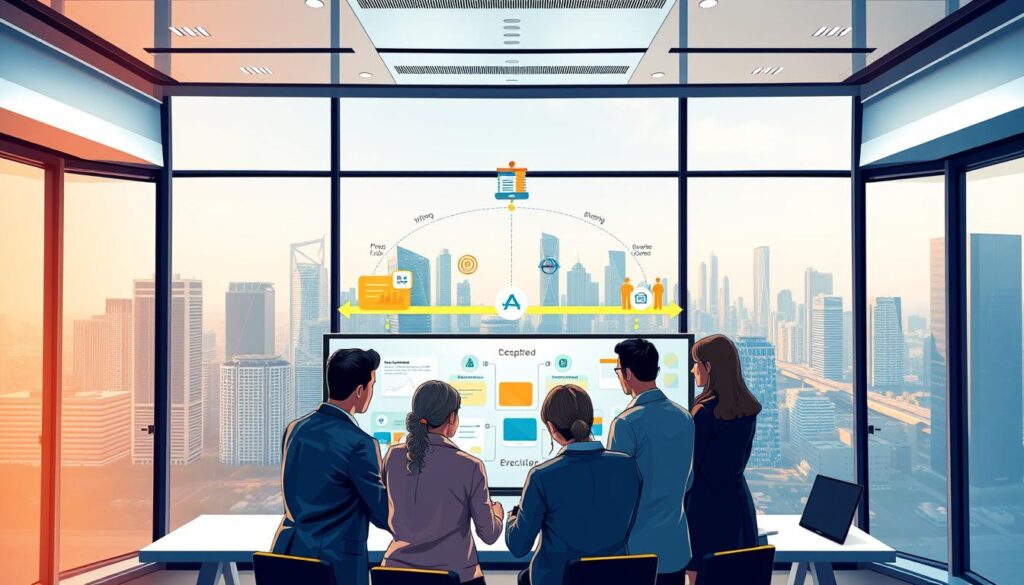In today’s fast-paced business environment, effective project management is crucial for success. As businesses continue to run numerous projects simultaneously, the demand for skilled project managers has skyrocketed. These professionals are sought after globally for their ability to oversee and deliver projects efficiently.
Aspiring project managers can benefit greatly from a comprehensive guide that covers the stages of project management, from grasping the basics to project closure. The Project Management Bootcamp: A Step-by-Step Guide is a valuable resource that provides a detailed roadmap for achieving PMP certification and mastering the skills required to excel in this field.
Key Takeaways
- Understanding the importance of project management in modern business environments.
- Recognizing the role of a project manager and the skills required.
- Learning the stages of project management covered in the step-by-step guide.
- Achieving PMP certification through comprehensive study materials.
- Mastering project management skills for global career opportunities.
What is a Project Manager?
Project managers play a crucial role in guiding projects from initiation to completion, ensuring they are executed efficiently and effectively. According to Coursera, a project manager is responsible for planning, executing, and monitoring a project.
Definition and Role
A project manager is a professional who oversees the planning, execution, and delivery of a project. Their role involves coordinating resources, managing stakeholders, and ensuring that the project is completed on time, within budget, and to the required quality standards. The project manager’s role is multifaceted, requiring a blend of technical, business, and interpersonal skills.
Key Responsibilities
The key responsibilities of a project manager include:
- Defining project scope, goals, and deliverables
- Developing and managing project plans, including timelines and budgets
- Coordinating and leading project teams
- Managing and mitigating project risks
- Ensuring quality standards are met
- Communicating with stakeholders and team members
Effective project managers must be adept at managing resources, timelines, and budgets, as highlighted in resources like World Civil Society, which provides insights into managing complex projects.
Essential Skills
To be successful, project managers must possess a range of essential skills, including:
- Leadership and Team Management: The ability to lead and motivate project teams.
- Communication: Effective communication with stakeholders, team members, and sponsors.
- Risk Management: Identifying and mitigating potential project risks.
- Time and Budget Management: Ensuring projects are completed on time and within budget.
- Problem-Solving: The ability to analyze problems and develop effective solutions.
By combining these skills with a deep understanding of project management methodologies and practices, project managers can deliver successful projects that meet their objectives.
The Importance of Project Management

Organizations that adopt robust project management practices are more likely to achieve their strategic goals. Effective project management is a cornerstone of organisational success, contributing to increased productivity, customer satisfaction, and overall business growth.
The benefits of project management are multifaceted. By implementing structured project management methodologies, organizations can enhance their operational efficiency, reduce costs, and improve customer satisfaction. For instance, adopting agile project management methodologies can facilitate flexibility and adaptability in project execution.
Benefits for Organizations
Project management offers numerous benefits to organizations, including improved resource allocation, enhanced team collaboration, and better risk management. By adopting a structured approach to project management, organizations can ensure that projects are completed on time, within budget, and to the required quality standards.
- Enhanced operational efficiency
- Improved customer satisfaction
- Better resource allocation
Impact on Success Rates
The impact of project management on success rates cannot be overstated. Effective project management practices lead to higher success rates, as they ensure that projects are well-planned, executed efficiently, and monitored closely. According to various studies, organizations that prioritize project management tend to have higher project success rates. For more insights on the importance of leadership in project management, it’s clear that leadership plays a crucial role in driving project success.
In conclusion, the importance of project management lies in its ability to drive business success, enhance productivity, and improve customer satisfaction. By adopting effective project management practices, organizations can achieve their strategic objectives and stay competitive in today’s fast-paced business environment.
Types of Project Management Methodologies
Project management methodologies vary widely, providing teams with the flexibility to choose the best approach for their projects. This flexibility is crucial as different projects have different requirements, and the chosen methodology can significantly impact the project’s success.
Waterfall Method
The Waterfall methodology is a traditional, linear approach to project management. It is characterized by a sequential design process where progress flows in one direction through the phases of conception, initiation, analysis, design, construction, testing, implementation, and maintenance. This method is ideal for projects with well-defined requirements and where changes are unlikely.
Agile Method
Agile project management is an iterative and adaptive approach that emphasizes flexibility and collaboration. It involves breaking down the project into smaller, manageable chunks, and working on them in iterations. This methodology is particularly useful for projects that require quick adaptations to change, making it a popular choice in today’s fast-paced business environment.
Hybrid Approaches
Hybrid project management methodologies combine elements of different approaches, such as Waterfall and Agile, to create a tailored methodology that suits the specific needs of a project. This approach allows teams to leverage the strengths of various methodologies, making it versatile and effective for complex projects. For instance, a project might use the Waterfall method for the overall structure but incorporate Agile principles for specific components that require flexibility.
Understanding the different project management methodologies is essential for project managers, especially those pursuing PMP certification, as it enables them to select the most appropriate approach for their projects, thereby enhancing their chances of success.
Project Management Lifecycle

The project management lifecycle is a series of phases that guide a project from its inception to its completion. Understanding these phases is crucial for effective project management.
Phases of Project Management
The project management lifecycle is typically divided into five phases: initiation, planning, execution, monitoring, and closure. Each phase has distinct objectives and outcomes that contribute to the overall success of the project.
- Initiation: This phase involves defining the project’s objectives, scope, and stakeholders. It’s where the project’s feasibility is assessed, and the project charter is developed.
- Planning: During this phase, a detailed project plan is created, outlining the tasks, timelines, resources, and budget required to complete the project.
- Execution: The project plan is put into action during the execution phase, where the project team carries out the tasks and activities outlined in the plan.
- Monitoring: This phase involves tracking the project’s progress, identifying and addressing any deviations from the plan, and taking corrective action as needed.
- Closure: The final phase involves formally closing the project, documenting lessons learned, and evaluating the project’s success.
For more detailed information on the project management lifecycle, you can refer to resources such as Coursera’s article on project management lifecycle.
Initiation, Planning, Execution, Monitoring, Closure
Each phase of the project management lifecycle is interconnected and builds upon the previous one. Effective transition between phases is crucial for maintaining project momentum and ensuring that the project stays on track.
| Phase | Key Activities | Outcomes |
|---|---|---|
| Initiation | Defining project scope, assessing feasibility, developing project charter | Project charter, defined scope |
| Planning | Creating project plan, outlining tasks, timelines, resources, budget | Detailed project plan |
| Execution | Carrying out tasks and activities outlined in the project plan | Project deliverables |
| Monitoring | Tracking progress, identifying and addressing deviations | Corrected project trajectory |
| Closure | Formally closing the project, documenting lessons learned | Project closure report, lessons learned document |
As noted by project management experts, understanding and effectively managing the project management lifecycle is key to delivering successful projects.
“A well-managed project lifecycle is crucial for achieving project objectives and ensuring stakeholder satisfaction.”
Career Path of a Project Manager
Embarking on a career as a project manager requires a strategic blend of education, certifications, and experience. As organizations continue to recognize the value of effective project management, the demand for skilled professionals in this field is on the rise.
Required Education and Certifications
To become a project manager, one typically needs a bachelor’s degree in a relevant field such as business administration, management, or engineering. Professional certifications like the PMP (Project Management Professional) certification offered by the Project Management Institute (PMI) are highly regarded and often preferred by employers. For those looking to advance their careers, pursuing a master’s degree or specialized certifications can be beneficial.
Some key certifications for project managers include:
- PMP (Project Management Professional)
- PRINCE2 (Projects in Controlled Environments)
- Scrum Master Certification
- Agile Certifications
For more information on career paths and certifications, visit Coursera’s article on project manager career.
Typical Job Titles and Progression
Project managers can start their careers in various roles and progress to more senior positions. Typical job titles include:
- Junior Project Coordinator
- Project Coordinator
- Project Manager
- Senior Project Manager
- Program Manager
- Portfolio Manager
As project managers gain experience, they can move into more complex projects or take on leadership roles within their organizations. The engineering management and project management fields often overlap, providing opportunities for career growth and diversification.
Essential Tools for Project Managers

To achieve project goals, managers must leverage a range of tools designed to streamline processes and enhance collaboration. In the realm of project management, having the right tools is not just a luxury, it’s a necessity.
The landscape of project management is dotted with various tools, each designed to address specific needs. These tools can be broadly categorized into project management software, collaboration tools, and time tracking solutions.
Project Management Software
Project management software is the backbone of any project, providing a centralized platform for planning, executing, and monitoring projects. Popular options include:
- Trello: Known for its Kanban boards and simplicity.
- Asana: Offers robust task management and tracking features.
- Microsoft Project: Provides comprehensive project planning and scheduling.
For more insights on utilizing technology in project management, visit this resource.
Collaboration Tools
Collaboration is key to project success, and the right tools can facilitate seamless communication among team members. Some popular collaboration tools include:
- Slack: Offers real-time messaging and file sharing.
- Microsoft Teams: Integrates with Microsoft Office 365 for comprehensive collaboration.
- Google Workspace: Provides a suite of productivity tools, including Gmail and Google Drive.
| Tool | Primary Function | Key Features |
|---|---|---|
| Trello | Project Management | Kanban boards, task assignment |
| Slack | Collaboration | Real-time messaging, file sharing |
| Harvest | Time Tracking | Time tracking, invoicing, reporting |
Time Tracking Solutions
Time tracking is essential for understanding project progress and managing resources effectively. Popular time tracking solutions include:
- Harvest: Known for its simplicity and invoicing features.
- Toggl: Offers easy time tracking and reporting.
- Clockify: Provides free time tracking with robust features.
By leveraging these tools, project managers can significantly enhance their ability to manage projects effectively, ensuring they are completed on time and within budget.
The Soft Skills Every Project Manager Needs
While technical skills are crucial, soft skills are what differentiate good project managers from great ones. Effective project management is as much about leading people as it is about managing tasks.
Communication Skills
Good communication skills are the backbone of successful project management. Project managers must be able to clearly articulate project goals, expectations, and timelines to their team. This involves not just speaking, but also listening actively to team members’ concerns and ideas.
As emphasized by a leading project management expert, “Effective communication is key to ensuring that all stakeholders are aligned and working towards the same objectives.”
Leadership Qualities
Leadership qualities are essential for inspiring and motivating team members. A project manager who can lead by example, demonstrate empathy, and make tough decisions when necessary will foster a positive and productive team environment.
Effective leadership is about more than just giving orders; it’s about inspiring, motivating, and enabling your team to perform at their best. As a project management thought leader once said,
“Leadership is not about titles, positions, or flowcharts. It is about one life influencing another.”
Conflict Resolution
Conflicts are inevitable in any team setting, making conflict resolution skills vital for project managers. The ability to mediate disputes, address issues promptly, and find solutions that satisfy all parties is crucial for maintaining a harmonious and efficient team.
- Active listening to understand the root cause of conflicts
- Remaining impartial to ensure fairness
- Encouraging open dialogue to resolve issues
By mastering these soft skills, project managers can significantly enhance their team’s performance and overall project success.
Building a Successful Project Team

Project management success hinges on building a cohesive and skilled team. A well-structured project team is essential for achieving project goals and objectives.
Strategies for Team Selection
Selecting the right team members is critical for project success. This involves identifying the necessary skills, expertise, and experience required for the project.
- Identify key roles and responsibilities
- Assess team members’ strengths and weaknesses
- Consider the team’s overall dynamics and compatibility
Fostering Collaboration
Fostering a collaborative environment is vital for team success. This can be achieved by promoting open communication, encouraging feedback, and building trust among team members.
“The way a team plays as a whole determines its success. You may have the greatest bunch of individual stars in the world, but if they don’t play together, the club won’t be worth a dime.”
Setting Clear Roles and Responsibilities
Clearly defining roles and responsibilities helps prevent confusion and overlapping work. It ensures that each team member understands their tasks and expectations.
| Role | Responsibilities |
|---|---|
| Project Manager | Oversees project planning, execution, and monitoring |
| Team Lead | Guides the team, assigns tasks, and monitors progress |
| Team Member | Completes assigned tasks and reports progress |
By implementing these strategies, project managers can build a high-performing team that is equipped to handle the challenges of project management.
Risk Management in Projects
Projects inherently involve risks that must be managed proactively. Risk management is a critical component of project management, enabling project managers to identify, assess, and mitigate risks that could impact the project’s success.
Identifying Risks
Identifying risks is the first step in risk management. It involves recognizing potential risks that could affect the project and documenting their characteristics. This process is crucial for project manager responsibilities, as it allows for the development of strategies to address these risks.
Effective risk identification involves a thorough analysis of the project’s scope, stakeholders, and external factors. Techniques such as brainstorming, SWOT analysis, and review of historical data are commonly used.
Mitigating Potential Issues
Once risks are identified, the next step is to develop strategies to mitigate or manage them. This involves assessing the likelihood and potential impact of each risk and prioritizing them accordingly. For more detailed information on mastering risk assessment, you can visit Mastering Risk Assessment in Project Management.
Mitigation strategies may include risk avoidance, risk transfer, or risk reduction. The goal is to minimize the negative effects of risks on the project. By proactively managing risks, project managers can ensure that their projects are more likely to succeed.
Budgeting and Financial Management

Budgeting is a foundational element of project management that directly impacts the project’s overall success. A well-managed budget ensures that resources are allocated efficiently, and expenses are kept in check, ultimately contributing to the project’s profitability and success.
Estimating Project Costs
Estimating project costs is a critical step in budgeting for project management. It involves predicting the costs of resources, labor, materials, and services required to complete the project. Accurate cost estimation helps in setting a realistic budget, avoiding cost overruns, and ensuring that the project is financially viable.
Key considerations for estimating project costs include:
- Historical data from similar projects
- Current market rates for materials and labor
- Potential risks and contingencies
As noted by a project management expert, “Accurate cost estimation is not just about numbers; it’s about understanding the project’s scope, complexities, and potential roadblocks.” Effective cost estimation requires a thorough understanding of the project’s requirements and the ability to predict potential expenses.
Monitoring Expenses
Monitoring expenses is equally important as estimating costs. It involves tracking actual expenses against the budget, identifying variances, and taking corrective actions when necessary. Continuous monitoring helps in maintaining financial discipline and ensuring that the project stays within budget.
Best practices for monitoring expenses include:
- Regularly reviewing financial reports
- Using project management software to track expenses
- Adjusting the budget as needed based on project progress
“A project manager’s ability to manage the budget effectively is crucial for the project’s success,” highlighting the importance of financial management in project management. Ultimately, the budget should be finally calculated, and cost centers closed upon project completion to ensure financial closure.
Measuring Project Success
Project success measurement is a vital aspect of project management that helps in evaluating the outcome of a project. It involves assessing whether the project has achieved its objectives and delivered the expected benefits.
Key Performance Indicators (KPIs)
Key Performance Indicators (KPIs) are quantifiable measures used to evaluate the success of a project. They provide insights into the project’s progress and help project managers identify areas that need improvement.
Common KPIs for Project Success:
- Project completion rate
- Budget variance
- Schedule performance index
- Customer satisfaction
- Team performance
| KPI | Description | Target |
|---|---|---|
| Project Completion Rate | Percentage of tasks completed on time | 95% |
| Budget Variance | Difference between actual and budgeted costs | <5% |
| Schedule Performance Index | Ratio of earned value to planned value | >1 |
Evaluating Outcomes
Evaluating project outcomes involves assessing the project’s deliverables and determining whether they meet the stakeholders’ expectations. This process helps in identifying lessons learned and areas for improvement.
Effective outcome evaluation requires a systematic approach that includes:
- Defining clear objectives and success criteria
- Establishing a robust monitoring and control system
- Conducting regular progress reviews
- Documenting lessons learned
The Future of Project Management

As we look ahead, project management is poised to undergo significant transformations driven by emerging trends and technologies. The field is on the cusp of a revolution, with various factors influencing its future trajectory.
Emerging Trends and Technologies
The project management landscape is being reshaped by several emerging trends and technologies. Some of the key developments include:
- Agile Project Management: Continuing to gain popularity, agile methodologies are becoming more sophisticated, enabling teams to respond quickly to change.
- Artificial Intelligence (AI): AI is starting to play a crucial role in project management, automating tasks, and providing predictive insights.
- Remote Work Tools: With the rise of remote work, collaboration tools are becoming essential for project managers to coordinate and communicate with their teams effectively.
The Role of AI in Project Management
AI is transforming project management by enhancing decision-making, improving forecasting, and automating routine tasks. According to a recent article on the future of project management, AI will continue to have a significant impact on the field.
Some of the ways AI is being utilized include:
- Predictive Analytics: AI algorithms can analyze historical data to predict project outcomes, helping managers make informed decisions.
- Resource Allocation: AI can optimize resource allocation by analyzing project requirements and team capabilities.
- Risk Management: AI-powered tools can identify potential risks and suggest mitigation strategies.
By embracing these emerging trends and technologies, project managers can stay ahead of the curve and drive success in their projects.
Conclusion and Next Steps
Effective project management is a critical skill that can be learned and mastered. As discussed throughout this guide, a project manager plays a vital role in ensuring the success of a project.
Key Takeaways
The role of a project manager involves overseeing the project lifecycle, from initiation to closure, and requires a combination of technical, business, and interpersonal skills. Understanding different project management methodologies, such as Agile and Waterfall, is crucial for adapting to various project needs.
Resources for Advancement
For those looking to advance their careers in project management, obtaining a PMP certification can be a significant step. This certification, offered by the Project Management Institute (PMI), demonstrates a professional’s expertise and commitment to the field of project management. Further learning resources, including online courses and professional networks, can also support continuous development as a project manager.
